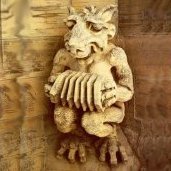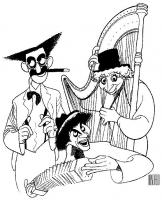-
Posts
4,686 -
Joined
-
Last visited
Everything posted by David Barnert
-
Start here and continue by searching on the word "films" in this forum.
-
I just wanted to say how much I am enjoying this thread. I play a lot of classical music, but mostly on cello and recorder. Most of my concertina playing (Wheatstone Hayden Duet concertina) is traditional stuff, but I play some classical as well. I'd also like to say that I think the photo that Juliette posted in the first post in this thread is a work of art. I'm tempted to say it could be the cover of a book or a movie poster, but it's too good for that. I can't wait to hear your playing, Juliette. If you haven't yet figured out thow to post your recordings, attach them by e-mail (numerous acceptable formats, but mp3 probably makes the most sense) to Henk van Aalten. His e-mail address is his name spelled out without the spaces, "at" gmail dot com. He will put them up on his web page, http://www.anglo-concertina.net/links.htm.
-

Best Father's Day Ever!
David Barnert replied to Mark Evans's topic in General Concertina Discussion
Sorry 'bout that. I love the way the picture almost looks like a painting. It makes it very warm and inviting. But detailed resolution where faces are concerned is not one of its strengths. Indeed. Jullie and I will be there for the Saturday evening performance (July 1) in Great Barrington. Any chance you will? -
Someone probably ought to have a look at it. Where are you located? You may not know that the Wheatstone manufacturing ledgers are available on line, and I have located the page that includes yours. It was made in February, 1954. Edited for typo
-

Best Father's Day Ever!
David Barnert replied to Mark Evans's topic in General Concertina Discussion
I assume that's Dominique under the umbrella with the dark shirt. Looks like she's singing. Must have been lovely (I've heard her sing and paid a lot of money for the privilege). -
Actually, I think that the reason that people object to ALL CAPS is that it is so difficult to read. People don't realize it and ascribe it to shouting, but I really think that is the reason. All caps may be fine for short headline-type announcements, but is very frustrating as extended text (a whole paragraph, say). Mixed caps and smalls have enough ascenders and descenders so that each word has its own shape and can be recognized at sight even if one does not take the time to parse each of the letters. In ALL CAPS, each word is just a big rectangle until you scrutinize the details. Just for the hell of it, here's that last paragraph again in all caps. Take my word for it that I'm not shouting. MIXED CAPS AND SMALLS HAVE ENOUGH ASCENDERS AND DESCENDERS SO THAT EACH WORD HAS ITS OWN SHAPE AND CAN BE RECOGNIZED AT SIGHT EVEN IF ONE DOES NOT TAKE THE TIME TO PARSE EACH OF THE LETTERS. IN ALL CAPS, EACH WORD IS JUST A BIG RECTANGLE UNTIL YOU SCRUTINIZE THE DETAILS. See what I mean? Edited for typo.
-

English Music Sessions Not In England
David Barnert replied to Chris Timson's topic in General Concertina Discussion
It's not unusual for general sessions around here (northeast USA) to veer into Playford territory for a few tunes at a stretch. -
I assume you're talking about one of these: There is no support for notation like this in abc v1.6, and I'm not aware of any software products that implement it above and beyond the abc standard (see my previous post of May 25). The only suggestions I can think of are these: Use a normal repeat but include the notation "4x" (with the quotes) before the last note before the repeat. This will not result in the file being played properly (it will play only twice, and might screw up software that expects to find a chord between the quotes and tries to play it) but most well-behaved abc software will write "4x" (without the quotes) over the last note, making the intention clear to any musician who looks at the printed output (perhaps even clearer than the four dots ). Write the lines out twice (well, actually, copy and paste). Edited to add: BTW, I'm not certain that the 4 dots really does mean "repeat four times" or even that it always means the same thing, but the above is written on the assumption that it does.
-

The Beatles And The Concertina
David Barnert replied to Perry Werner's topic in General Concertina Discussion
No, as with his bass guitar (strung backward) he would have an instrument prepared in mirror image to a right-handed concertina. Libba Cotten or Bill Staines would play a rightie concertina upside down. Happy 64, Paul. -

Is A Chemitzer An Anglo ?
David Barnert replied to Alan Day's topic in General Concertina Discussion
The Anglo also benefitted from English construction practices, hence it's true name, the Anglo-German concertina, called "Anglo" for short. The Bandoneon and Chemnitzer are descended from the German (Uhlig) concertina, but can only be considered cousins to the Anglo-German (which also descends from the German). -
Two points: The dictum about not using lubricants has often been repeated by folks who should know, so I believe it even though I have no personal experience with it. DoN Nichols, for instance, says that any lubricant may find its way out of the place where you applied it and into places where it will undermine the glues that hold wood and/or leather together. Are you sure it's the riveted action that's squeaking? Look closely at the pads and make sure one isn't rubbing against its neighbor. That has been the source of every concertina squeak I have ever investigated. The treatment is to stop them from rubbing (i.e., gently bend a lever), not to lubricate.
-
Here's an old Al Hirschfeld drawing of the Marx Brothers with Chico playing the concertina. When I first saw this image (in Hirschfeld's obituary in 2003), I posted a question about it here (in the old forum). Nobody could recall an instance of Chico actually playing (or even pretending to play) a concertina. Edited for spelling.
-

Redneck Dialect Concertinas
David Barnert replied to greenferry's topic in General Concertina Discussion
Sounds like a line from the movie, "Smoke Signals." Bunch of American Indians sitting around watching TV. One says: Then, of course, suppose someone made a movie about... One of the silliest things I ever heard was a guy from Poland and a guy from Fort Worth, Texas (both in Massachusetts at the time) trying to imitate each other's accents. Edited for Typo -
My credit card is through Citibank and they have a setup called "Virtual Account Numbers." Whenever you need to send a credit card over the internet (you can also use it for phone orders) you get a one-use-only number that gets charged to your regular account. You can even limit the dollar amount. See details at www.myvirtualaccountnumbers.com. Only thing you can't use it for, of course, is automatic payment of recurring charges.
-
One thing I can tell you is it's not a concertina. There may be folks here who can tell you more, but you're more likely to find help at melodeon.net.
-
No prob. Aplogy accepted. I made a mistake once.
-
That will work, but if you do it frequently, you might find it more efficient to have abc software (that does the same thing as the tune-o-tron) resident on your computer.
-

Newbie Question - Long And Drawn Out
David Barnert replied to viejomc's topic in Teaching and Learning
When I was in college I responded to a similar request by writing a loud blues-y song called "Far Far Away." Here's the words. The first two lines are straight 12-bar blues. The other two lines expand things a bit without losing the feeling (the whole thing has 16 bars, 4 per lne). -
There would be no way to tell if they have two or four beats. The notation would be the same except for the time signature (C or C|). They both have measure with four quarters (crochets), but in C| each crochet gets only half a beat.I am very much a beginner in music theory etc, but wouldn't the 2/2 tend to have an equal emphasis on the first and third crotchets, whereas the the 4/4 would have the main empahsis on the first crotchet and less emphasis on the third crochet?Yes, but I think you are misunderstanding the question I was answering. We're talking about notation as it appears on paper or computer screen, not how it sounds or is played. Robin said he had seen notation with a time signature that implied 2/2 but seemed to have 4 beats to the measure. I replied that 4 beats in 4/4 looks on paper just like 2 beats in 2/2. I agree they are played differently, but that's not what the question was.
-
I heard a story once about a guy who got an anglo concertina and was the only one in the state at the time (New Mexico?). He took it out of the box backward and taught himself to play it in isolation, never realizing he had it the wrong way 'round until many years later when he met another concertina player. You couldn't do it on an english (the thumb loops would be on the bottom and the pinkie rests on top). A Hayden can be played that way, but not without noticing. The rows would slant the wrong way.
-
The Bastari 46 button, on the other hand was a dream, in some ways, smoother than my Wheatstone. I still have them both. The main disadvantages of the Bastari are the sound and the frequent need for quick (or not so quick) repairs.
-
There would be no way to tell if they have two or four beats. The notation would be the same except for the time signature (C or C|). They both have measure with four quarters (crochets), but in C| each crochet gets only half a beat. (Currently visiting Chicago)
-
All these years... I think I've been wiping with the wrong hand. Of course all this has become much less of an issue since the invention of soap.
-
I had a chance to play that same instrument (I understand Bastari only made two of them) when it lived in Vermont with its previous owner. It is very heavy and poorly balanced, making it quite cumbersome to play. Each of the 67 buttons has 4 reeds (instead of the usual two, out and in), tuned in octaves.
-
American answer: I always notate reels in cut time (2/2). It's played exactly as if it were in 2/4, but the copy looks much cleaner because instead of 8th notes and 16th notes, there's quarters and 8ths, ie., fewer flags and beams for the same note values. Now translated into British: I always notate reels in cut time (2/2). It's played exactly as if it were in 2/4, but the copy looks much cleaner because instead of quavers and semiquavers, there's crotchets and quavers, ie., fewer flags and beams for the same note values. In classical music, 2/2, or cut time is usually seen in marches, for the same reason. The beat counts the steps, and using 2/2 rather than 2/4 makes the page visually easier to parse.



